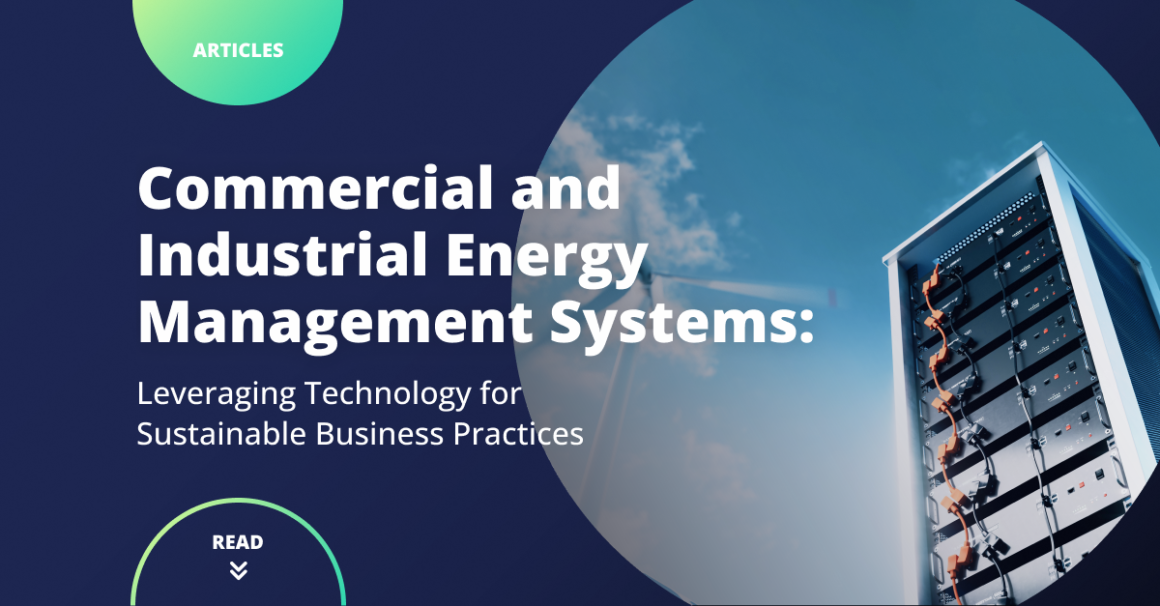Commercial and Industrial Energy Management Systems

At Codibly, we are passionate about the transformative power of technology, particularly in the area of sustainability. Technology is crucial in addressing some of the world’s most challenging environmental challenges. In this article, we will explore the role of technology in energy management systems for commercial and industrial businesses, drawing insights from industry pioneers.
Energy Management Systems: A Game-Changer for Businesses
Energy Management Systems (EMS) are revolutionizing the way commercial and industrial businesses approach energy consumption. These systems enable companies to transform their sites into mini power stations by installing solar panels, battery energy storage systems (BESS), and EV chargers on-site. Hardware alone won’t create an effective EMS, software is also critical to being able to optimize generation, storage and load management, allowing businesses to reduce costs, reduce consumption, and reduce emissions. The best part? If set up properly, a BMS should automate most processes so that they run in the background, requiring little time and effort to extract value.
In simple terms, the energy-as-a-service model means that businesses pay a lower rate to the energy management system provider instead of paying the grid or supplier a certain amount per kilowatt-hour. In return, the provider takes care of everything – from installing the solar panels and battery to setting up the management system. They take on all the risk and investment, providing customers with a straightforward and simple option.
The Transformative Power of AI and Machine Learning
Artificial Intelligence (AI) and Machine Learning (ML) are integral components of advanced energy management systems. These technologies are used to predict on-site activities and market trends, allowing for forward planning of generation, storage, and usage of electricity on a site.
This predictive capability results in more accurate forecasts, which in turn leads to more savings for the end user. But the innovation doesn’t stop there. Providers are continuously improving their AI and ML models, integrating more intelligence and updating their algorithms. This constant evolution ensures they stay competitive and continue to provide value to their customers.

The Future of Energy Management Systems: Tech-Forward Initiatives and Market Expansion
Looking ahead, the industry is excited about several upcoming tech-forward initiatives. One of these is the launch of batteries on fully dynamic tariffs. This system will allow businesses to use electricity at the right time, store it in the battery at the right time, and export it at the right time.
Here, the term “right time” is critical. But what does “the right time” really signify in this context? In the realm of energy management it references the precise moments when:
- Electricity Demand and Cost are Low: With dynamic tariffs, electricity prices fluctuate based on demand. During off-peak hours, when electricity consumption is at its lowest, prices drop. This is the optimal moment for businesses to draw from the grid, maximizing savings.
- Energy Storage is Optimal: Storing energy in batteries during periods when electricity is cheaper (like during sunny days for solar or off-peak hours) ensures businesses have a backup when prices are high or in case of power outages.
- Energy Export is Most profitable: Conversely, during peak hours when electricity demand is high, businesses can export their stored energy back to the grid. Dynamic tariffs mean customers can sell this energy at a premium.
Another exciting development is the incorporation of imbalance trading into a day-ahead forecast. Suppliers often mismatch their predictions with real-time demand or supply. Imbalance trading capitalizes on these gaps, potentially doubling revenues from day-ahead trades. On the hardware side, the surge in DC-connected solar and battery systems is noteworthy. Unlike traditional setups that switch between AC and DC, causing energy losses, these systems maintain a direct, efficient link between solar generation and storage. This innovation promises greater efficiency and cost savings, especially for mid-sized businesses.
But the vision extends beyond technology. There is also a focus on geographical expansion, with an interest in bringing solutions to other countries in Central and Eastern Europe, including Poland, the Nordics, Netherlands, Belgium, and potentially Germany. These markets present exciting opportunities due to their fluctuating electricity prices and increasing adoption of renewables.
Conclusion: The Pioneering Role of Technology in Energy Management Systems
The innovative use of AI, ML, and other technologies, coupled with customer-centric business models, positions energy management systems as a leader in the industry. At Codibly, we’re excited to see what the future holds for this sector and how these pioneering works will shape the future of renewable energy.

Codibly: A Partner in Innovation
Our expertise in the US and emerging markets has given us a possibility to gather insights into the unique challenges that businesses face in the evolving energy landscape. We dive deeper than just predictions; we use AI to drive actionable strategies, ensuring businesses can navigate and capitalize on market shifts. The focus isn’t solely on cutting-edge technology but also on its practical application. In the dynamic world of energy management systems, effective energy balancing is paramount.
At Codibly, we craft solutions that enhance operational efficiency while aligning with green goals, always keeping in view the broader picture presented in this article: a future driven by tech-savvy, sustainable solutions.
Stay tuned to Codibly blog for more insights and updates. We are committed to sharing the latest trends, insights, and innovations in the tech and sustainability sectors, helping businesses understand how they can leverage technology to drive sustainable growth.
contact us
Need expert guidance on your next energy project?
Reach out to us and discover how Codibly can offer tailored solutions to drive your business.